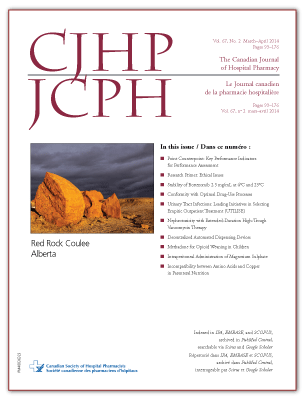Conformity with Optimal Drug-Use Processes: Comparison between the Accreditation Canada Managing Medications Standards and the Hospital Pharmacy in Canada Report
DOI:
https://doi.org/10.4212/cjhp.v67i2.1335Keywords:
accreditation, pharmacy practice, comparisons, agrément, pratique de la pharmacie, comparaisonsAbstract
ABSTRACT
Background: A recent symposium on change management highlighted the relatively slow pace of change in the drug-use process. This study was undertaken to determine the degree of concordance between different sources that document levels of conformity with optimal druguse processes.
Objective: The primary objective was to compare aggregate national results from the Managing Medications Standards (MMS) of Accreditation Canada and results from the biennial Hospital Pharmacy in Canada survey. The secondary objective was to discuss any significant discrepancies between the 2 sources.
Methods: In this retrospective cross-sectional study, attempts were made to pair each Accreditation Canada MMS criterion with specific results from the Hospital Pharmacy in Canada 2009/2010 Report. Average conformity per criterion from the 2010 Accreditation Canada on-site surveys was compared with conformity as documented in the Hospital Pharmacy in Canada 2009/2010 Report. A discrepancy ratio was calculated for each criterion, with ratios less than 0.80 or greater than 1.20 being considered significant.
Results: Overall, 82 (61%) of 134 MMS criteria could be paired with results from the 2009/2010 Hospital Pharmacy in Canada survey. The average calculated discrepancy ratio (± standard deviation) between the 2 sets of results was 0.62 ± 0.29 (range 0.05 to 1.19). The average discrepancy ratios by domain were as follows: 0.49 for safely administering medications, 0.58 for accurately preparing and dispensing medications, 0.61 for working together to promote medication safety, 0.62 for carefully selecting and procuring medications, 0.69 for monitoring quality and achieving positive results, 0.71 for appropriately ordering medications and transcribing medication orders, and 0.76 for
properly labelling and storing medications. For 59 criteria, there was a significant discrepancy between the 2010 MMS on-site surveys and the 2009/2010 Hospital Pharmacy in Canada survey. Conclusion: Nearly two-thirds of the MMS criteria could be paired with results from the Hospital Pharmacy in Canada survey, but the average discrepancy ratio of 0.62 indicates substantial discrepancies in the data collected by these 2 methods. Further studies are required to explore the reasons for such discrepancies.
Conclusion: Nearly two-thirds of the MMS criteria could be paired with results from the Hospital Pharmacy in Canada survey, but the average discrepancy ratio of 0.62 indicates substantial discrepancies in the data collected by these 2 methods. Further studies are required to explore the reasons for such discrepancies.
RÉSUMÉ
Contexte : Un récent colloque sur la gestion du changement soulignait la lenteur du changement dans le processus de distribution des médicaments. Cette étude a été entreprise afin de déterminer le degré de concordance entre différentes sources qui rassemblent des informations sur les degrés de conformité aux processus optimaux de distribution des médicaments.
Objectif : L’objectif principal était de comparer la somme des résultats nationaux des normes sur la gestion des médicaments (NGM) d’Agrément Canada aux résultats du sondage bisannuel sur les pharmacies hospitalières canadiennes. Le second objectif était d’étudier tout écart important entre les deux sources.
Méthodes : Dans cette étude rétrospective transversale, on a tenté d’apparier chaque critère des NGM d’Agrément Canada à des résultats précis du Rapport 2009-2010 sur les pharmacies hospitalières canadiennes. Le degré moyen de conformité calculé pour chaque critère sur l’ensemble des visites d’Agrément Canada en 2010 a été comparé au degré de conformité dont fait état le Rapport 2009-2010 sur les pharmacies hospitalières canadiennes. Un indice d’écart a été calculé pour chaque critère. Les indices d’écart inférieurs à 0,8 et supérieurs à 1,2 étaient considérés comme importants.
Résultats : En tout, 82 (61 %) des 134 critères des NGM ont pu être appariés à des résultats du sondage sur les pharmacies hospitalières canadiennes de 2009-2010. L’indice moyen d’écart (± écart-type) entreles deux ensembles de résultats était de 0,62 ± 0,29 (étendue de 0,05 à 1,19). Les indices moyens d’écart par domaine étaient : 0,49 pour l’administration sécuritaire des médicaments, 0,58 pour la préparation et la distribution des médicaments avec précision, 0,61 pour le travail d’équipe visant à promouvoir la sécurité des médicaments, 0,62 pour l’attention portée à la sélection et à l’approvisionnement en médicaments, 0,69 pour la gestion de la qualité et l’atteinte de résultats positifs, 0,71 pour l’émission et la transcription appropriées d’ordonnances de médicaments, et 0,76 pour l’étiquetage et l’entreposage convenables des médicaments. Il y avait un écart important, pour 59 critères des NGM, entre les résultats des visites d’Agrément Canada en 2010 et ceux du sondage sur les pharmacies hospitalières canadiennes de 2009-2010.
Conclusion : Près des deux tiers des critères des NGM ont pu être appariés à des résultats du sondage sur les pharmacies hospitalières canadiennes, mais l’indice moyen d’écart de 0,62 montre qu’il y a d’importants écarts entre les données recueillies par ces deux méthodes. D’autres études sont nécessaires afin d’explorer les raisons de tels écarts.
Downloads
Published
Issue
Section
License
Copyright © Canadian Society of Healthcare-Systems Pharmacy.
After publication of a manuscript in the CJHP, the authors of the manuscript must obtain written permission from the CSHP (publications@cshp.ca) before reproducing any text, figures, tables, or illustrations from the work in future works of their own. If a submitted manuscript is declined for publication in the CJHP, all said rights shall revert to the authors. Please note that any forms (e.g., preprinted orders and patient intake forms) used by a specific hospital or other health care facility and included as illustrative material with a manuscript are exempt from this copyright transfer. The CJHP will require a letter from the hospital or health care facility granting permission to publish the document(s).










